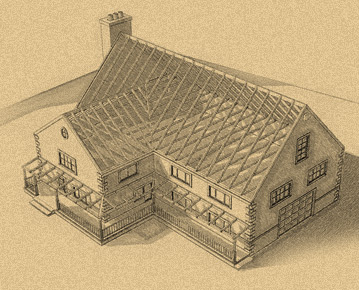VENTILATION
Typical household activities can wreak havoc on a roof and attic if proper roof ventilation is not provided:
- In the summer, heat build-up encourages the premature aging and cracking of wood and other roofing materials. Unwanted heat also can transfer back down into living areas – which reduces energy efficiency.
- In cold weather, warm air generated by laundry, showers, dish washing and cooking can linger in the house and cause moisture build-up.
The only way to combat these problems is with a balanced Top of the House® roofing system. That means it’s important to have proper ventilation, plus the appropriate amount of attic insulation to maximize performance.
In a balanced system, wind blowing over the ridge creates negative pressure that draws the warmer air out of the attic. Replacement air then enters through the undereave or soffit vents, bathes the underside of the roof, and exits at the ridge cap through ridge, roof or gable vents. Even without wind, the natural convection action of rising warm air maintains a continuous air flow along the underside of the roof.
Ultimately, proper ventilation — along with attic insulation — helps maintain a comfortable temperature inside a home, increase energy efficiency, prevent moisture damage and contribute to the longevity of a roof.
Determining Your Ventilation requirements
The following U.S. Department of Housing and Urban Development Statutes covering the ventilation of structural space are basic guidelines to determine the proper ventilation styles and sizes for any home. These statutes appear in the latest edition of the “Minimum Property Standards” (MPS 403-3).
The The Correct Amount of Roof Ventilation:
- As a general rule, one square foot of net vent area per 300 square feet of attic floor or area to be vented is recommended.
- In the rare situation where no vapor retarder is used and proper distribution of undereave and ridge vents cannot be achieved, one square foot of net vent area should be provided for each 150 square feet of attic floor or area to be vented.
- For a balanced system, ventilation should be equal at the undereave and ridge.
- In cases where a balanced system cannot be achieved, always provide more than 50% of the total required ventilation at the undereave and the remainder at the upper portion of the roof.
Poor Attic Ventilation Can Ruin Your Insulation, Destroy Your Shingles, And Raise Your Energy Bills!
Why Take Risks?
It is estimated that 9 out of 10 homes in North America do not have proper attic ventilation. Why? Because most people are unaware that attic ventilation can impact the longevity of their entire home!
For example, in the summer, improper ventilation can cause attic heat to build in excess of 160°F. This super-heated air eventually penetrates the ceiling insulation into the living area below.
Types of damage that can result include:
- Premature aging of your roofing system (“fried” shingles)
- Warping, cracking, or breaking down of wood framing
- Damage to siding, exterior or interior paint, and wallpaper
- Higher energy costs
A properly ventilated attic can help reduce the load on your air conditioner by moving the super-heated air out of your attic before it builds up and causes damage.
In the winter, various household appliances, bathtubs, showers, and cooking vapors can contribute to excess moisture build-up. Improperly ventilated attics will allow this moisture to collect and cling to the underside of the roof. The moisture will condense and fall, soaking the attic insulation and reducing its efficiency.
Additional structural damage can include:
- Roof deck warping and rotting of the wood frame
- Mildew growth
- Buckling of shingles and felt

Ventilation Ensures a Healthier, More Durable Roof
The Natural Ventilation
A natural ventilation system utilizes ventilators installed in openings in the attic and properly positioned to take advantage of natural air flow to draw hot summer or moist winter air out and replace it with fresh outside air.
Roof Ventilation Benefits

- Allows outside air to flow naturally
upward and out of attic. - Promotes a cooler, drier attic.
- Helps prevent moisture from becoming
trapped in insulation, structural wood,
shingles and roof deck. - Helps prevent rotting, mildew, drywall
damage, peeling paint and warped siding. - Provides year-round performance for
consistent ventilation without energy consumption.
Finally, attics should be properly ventilated to help prevent ice dams in cold northern climates. During the winter, ice and snow on a roof will melt and run down the deck to the cooler eaves. This run-off can re-freeze, creating an ice dam that may force water back up under the shingles and leak into your home — causing hundreds or thousands of dollars of damage to your ceilings and walls. Adequate attic ventilation reduces the amount of initial melting that occurs on your roof, thereby reducing the chance that ice dams will form.
